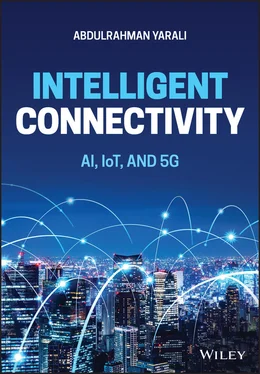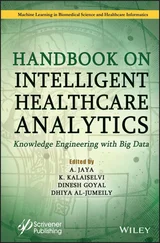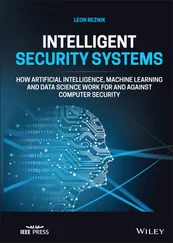The right of Abdulrahman Yarali to be identified as the author of this work has been asserted in accordance with law.
Registered Offices John Wiley & Sons, Inc., 111 River Street, Hoboken, NJ 07030, USA John Wiley & Sons Ltd, The Atrium, Southern Gate, Chichester, West Sussex, PO19 8SQ, UK
Editorial Office The Atrium, Southern Gate, Chichester, West Sussex, PO19 8SQ, UK
For details of our global editorial offices, customer services, and more information about Wiley products visit us at www.wiley.com.
Wiley also publishes its books in a variety of electronic formats and by print‐on‐demand. Some content that appears in standard print versions of this book may not be available in other formats.
Limit of Liability/Disclaimer of Warranty MATLAB® is a trademark of The MathWorks, Inc. and is used with permission. The MathWorks does not warrant the accuracy of the text or exercises in this book. This work’s use or discussion of MATLAB® software or related products does not constitute endorsement or sponsorship by The MathWorks of a particular pedagogical approach or particular use of the MATLAB® software. While the publisher and authors have used their best efforts in preparing this work, they make no representations or warranties with respect to the accuracy or completeness of the contents of this work and specifically disclaim all warranties, including without limitation any implied warranties of merchantability or fitness for a particular purpose. No warranty may be created or extended by sales representatives, written sales materials or promotional statements for this work. The fact that an organization, website, or product is referred to in this work as a citation and/or potential source of further information does not mean that the publisher and authors endorse the information or services the organization, website, or product may provide or recommendations it may make. This work is sold with the understanding that the publisher is not engaged in rendering professional services. The advice and strategies contained herein may not be suitable for your situation. You should consult with a specialist where appropriate. Further, readers should be aware that websites listed in this work may have changed or disappeared between when this work was written and when it is read. Neither the publisher nor authors shall be liable for any loss of profit or any other commercial damages, including but not limited to special, incidental, consequential, or other damages.
Library of Congress Cataloging‐in‐Publication Data
Names: Yarali, Abdulrahman, author.
Title: Intelligent connectivity : AI, IoT, and 5G / Abdulrahman Yarali.
Description: Hoboken, NJ, USA : Wiley, 2022. | Includes bibliographical references and index.
Identifiers: LCCN 2021033024 (print) | LCCN 2021033025 (ebook) | ISBN 9781119685180 (hardback) | ISBN 9781119685234 (adobe pdf) | ISBN 9781119685210 (epub)
Subjects: LCSH: Internet of things. | 5G mobile communication systems. | Artificial intelligence–Industrial applications.
Classification: LCC TK5105.8857 .Y369 2022 (print) | LCC TK5105.8857 (ebook) | DDC 004.67/8–dc23
LC record available at https://lccn.loc.gov/2021033024LC ebook record available at https://lccn.loc.gov/2021033025
Cover Design: Wiley
Cover Image: © metamorworks/Shutterstock
This book is dedicated to my kids, Fatemeh Zahra and Sadrodin Ali
The Oxford English Dictionary defines intelligence as acquiring and applying knowledge and skills. Its three definitions of intelligence demonstrate that humans and devices, buildings, and computers can possess such knowledge and skills. Intelligent connectivity is a concept that foresees the combination of high‐speed fifth‐generation (5G) networks, Artificial Intelligence (AI), and the Internet of Things (IoT) to accelerate technological development and structural changes paving the roads to enable new disruptive digital services. AI, 5G, and IoT advances are now enhancing each other, making the fifth wave of computing. The convergence of IoT, 5G wireless, and AI technologies are said to be some of the most exciting times for computing and technology and will usher in a new age of intelligent connectivity. Intelligent connectivity is not about a single product or device but a very complicated ecosystem expected to play a major role in bringing industry 4.0. These technologies work in sync with ubiquitous hyper‐connectivity, giving the users contextualized and personalized experiences. This phenomenon will significantly impact people, industries, governments, and organizations, transforming our way of life and work. The prospects at hand would be intelligent transport in self‐driving cars, intelligent healthcare systems, intelligent public safety and security systems, smart farming, smart city, entertainment, workplace, and many other sectors. Therefore, openness and exchanges across industries are needed.
Various AI applications range from Machine Learning, Deep Learning, Automation, and Autonomy, to Human–Machine Teaming. The implementation of AI through the IoT in different sectors of human life will significantly impact the field of business and job employment. However, AI is a pivotal enabler of intelligent connectivity, currently in its infancy, and human beings are just into the so‐called “narrow” or “weak AI” today. Whether to deploy AI in the cloud or at the edge of network connectivity, many real‐life applications, and use cases opt for a hybrid cloud‐edge approach.
5G networks provide higher data rates than 4G/LTE leveraging directional antennas, millimeter‐wave radio frequency, and edge computing solutions. In addition to higher data transfer rates, the 5G provides ultra‐low latency, ideally less than 1‐ms delay needed for some portable or mobile apps and services, for example, haptic internet, virtual reality, industrial automation, and robotics. The 5G network, unlike 4G/LTE, presents a focused purpose‐built technology designed and specifically engineered to facilitate the connected devices and automation system. The prospect positions 5G as a facilitator and catalyst to the next industrial age, referred to as industry 4.0. There is a clear need to forecast beyond smart factories, intelligent goods, and services towards enterprise as a whole and offer new unique benefits of the higher capacity urban wireless application.
IoT refers to a collection of standards for a new generation of “smart” products. These “smart” products, like embedded systems, have computer hardware integrated into them that allows for the gathering, processing, and contextualizing of data from their environment and sharing it across a network. Smart connected products provide more excellent reliability, expanding opportunities, much high utilization of the product, and its capabilities of transcending traditional products. It involves strategic choices of creating and capturing products, newly generated data, and relationship with conventional business partners. It highlights the opportunities of smart products produced through smart products, which are named ‘Internet of Things.’ IoT devices can be self‐adapting, self‐configuring, and interoperable. IoT devices use several communication protocols, including ones used by mobile phones. The deployment of 5G can help expand IoT devices deployment while reducing the networks' complexity that utilizes them as the number of devices increases. Together, 5G and IoT technology could allow for faster deployment of networks for virtually every application at the business and consumer levels of industry and commerce. However, when both technologies are combined with AI, intelligent connectivity becomes possible.
All these ever‐evolving technologies need to work together to create immersive experiences other than creating several separate devices for consumers. Almost half of the global population (3.8 billion people) are now mobile internet users, forecast to reach 61% (5 billion) by 2025. According to the Global Mobile Suppliers' Association, the Global Mobile Economy will be valued at $4.9 trillion by 2024 as 5G Ramps Up. 4G will continue to grow over the coming years, increasing to 56% of connections by 2025. Mobile operators are expected to spend $1.1 trillion worldwide between 2020 and 2025 in mobile CAPEX, roughly 80% of which will be on 5G networks. Fifty operators had launched 3GPP‐compliant 5G commercial services across 27 countries; 328 operators in 109 countries were investing in 5G.
Читать дальше












